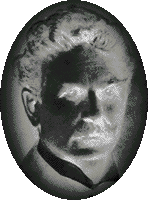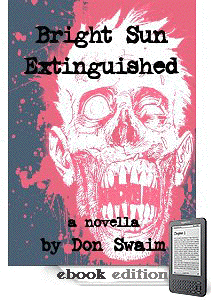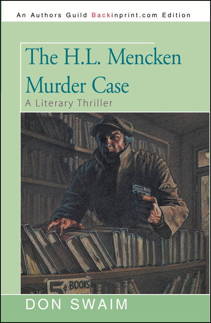 |
_______________________________________
Ambrose Bierce
CHRONOLOGY
Life & Disappearance
1842-1914?
compiled by Don Swaim
_______________________________________ |
Jun 24, 1842 — Born near Horse Cave Creek, Meigs County, Ohio, to Marcus and Laura Bierce. Youngest of 10 siblings.
1846 — Family moves to Walnut Creek, three miles south of Warsaw, Kosciusko County, Indiana.
1857 — Becomes a printer's devil for The Northern Indianan, Warsaw.
1859 — Attends the Kentucky Military Institute for one year.
1860 — Works as a laborer in George Steeple's brickyard, later as an employee at the retail store of A.E. Farber, Elkhart Indiana.
Apr 19, 1861 — Enlists as a private in Company C of the Ninth Regiment, Indiana Volunteers.
Jun 3, 1861 — Sees first military action in skirmish with Confederates at Philippi, Virginia.
Jul 10, 1861 — Heroically rescues a mortally injured soldier while under Confederate fire at Girard Hill, West Virginia.
July 19, 1861 — Ends first tour of duty.
Aug 27, 1861 — Re-enlists for three-year tour with rank of sergeant [Bierce's personal records note the date as Aug 15, 1861].
Feb 1862 — Reassigned to Hazen's Brigade of Buell's Army of the Ohio and shipped to Nashville. Named topographical officer to General Hazen.
Apr 1862 — Battle of Shiloh and the siege of Cornith, Mississippi.
Sep 12, 1861 — Promoted to sergeant-major, making him senior non-commissioned officer in regiment.
Dec 1, 1862 — Promoted to second lieutenant.
Dec 26, 1862 — Battle of Stones River.
Feb 14, 1863 — Promoted to first lieutenant.
Sep 20, 1863 — Battle of Chickamauga.
Nov 24, 1863 — Battle of Missionary Ridge.
Feb 1864 — Re-enlists for a third tour.
May 27, 1864 — Battle of Pickett's Mill.
Jun 23, 1864 — Wounded in the head by Confederate sniper during the battle of Kennesaw Mountain, Georgia, and evacuated to a military hospital in Chattanooga.
Sep 1864 — Returns to his brigade.
Oct 1864 — Captured by Confederate guerrillas along the Coosa River, Alabama, but escapes [Bierce himself makes this claim, but there is no independent verification]
Nov 1864 — Battle of Franklin, Tennessee. Named brevet captain.
Jan 16, 1865 — Honorably discharged from the military at Huntsville, Alabama.
Mar 13, 1865 — Named brevet major, an honorary title for distinguished service in the war.
Apr 1865 — Federal Treasury agent, Selma, Alabama. Bandits attack his steamboat loaded with confiscated cotton on the Tombigbee River.
Sep 1865 — Visits New Orleans and Panama; begins a journal, his first serious writing.
winter 1866 — Resigns Treasury appointment, returns to Indiana, applies for a captaincy in US Army.
summer 1866 — Joins General Hazen as engineering attache in dangerous military expedition through Indian territory to inspect Western military posts.
Nov 1866 — Arrives San Francisco with Hazen expedition, application for captaincy denied, takes a job as watchman at US Branch Mint.
Sep 21, 1867 — First published work in the Californian, a poem called "The Basilica."
Dec 1867 — Publishes his first non-fiction, "Female Suffrage," in the Californian.
July 1868 — Publishes articles in The Golden Era and the News-Letter.
summer 1868 — Joins the staff of the News-Letter.
Dec 12, 1868 — Becomes editor of the News-Letter. Writes "The Town Crier" column. Meets Mark Twain who visits the News-Letter to repay a loan.
1870 — Moves to San Rafael, hoping the climate will help his asthma.
Jan 1871 — Publishes his first short story, "The Haunted Valley," in the Overland, edited by Bret Harte.
Dec 25, 1871 — Marries Mary Ellen (Mollie) Day in San Francisco.
Mar 9, 1872 — Resigns from the News-Letter and moves with Mollie to London. Writes for the younger Tom Hood's humor magazine Fun under pseudonym "Dod Grile." Contributes to the magazine Figaro.
Jul 1872 — Publishes first book, The Fiend's Delight, for John Camden Hotten under Dod Grile pseudonym.
Dec 18, 1872 — Son Day born in Bristol, England, where the Bierces had moved from London.
winter 1873 — Moves to Bath, England.
summer 1873 — Moves to Hampstead, England.
fall 1873 — Visits Paris for two months. Publishes second book, Nuggets and Dust (Chatto and Windus).
winter 1873 — Dines with Mark Twain and Joaquin Miller in a riotous celebration at the Friars Club, London.
May 1874 — Edits a short-lived magazine, The Lantern.
Apr 29, 1874 — Second son, Leigh, is born.
1875 — Publishes third book, Cobwebs from an Empty Skull (Routledge and Sons).
May 1875 — Mollie, Day, and Leigh return to San Francisco.
Oct 1875 — Rejoins his family in San Francisco, obtains employment in the Assay Office of the Branch Mint.
Oct 30, 1875 — Daughter Helen born in San Francisco.
1876-77 — Serves as secretary to the Bohemian Club.
Mar 1877 — Named associate editor of the Argonaut, writes a column, "The Prattler." Pulls his pistol on an angry reader who attacks him in the Argonaut office.
Jun 1877 — Contributes to a hoax, a book called The Dance of Death by "William Herman," followed by a "rebuttal," The Dance of Life by "J. Milton Sloluck."
1877 — Moves to San Rafael, Marin County.
Jun 1880 — Hired as general agent of the Black Hills Placer Mining Company, Rockerville, South Dakota. Fights off road agents attempting to rob a money shipment between Deadwood and Rockerville.
Dec 1880 — Travels to New York to learn the mining company is insolvent. Returns in defeat to California.
Mar 1881 — Contributes to San Francisco Wasp, and resumes his column "Prattle." Begins series of definitions in his column titled "The Devil's Dictionary." Becomes editor in mid-July.
1882 — Moves to Oakland, California. Savagely attacks Oscar Wilde in the Wasp during Wilde's first tour of America.
1882 — Moves to Auburn, California.
1885 — Moves to St. Helena, Napa County.
Jul 1885 — Wasp is sold, Bierce leaves editor's chair, but becomes regular contributor.
Sep 1886 — Last contribution to the Wasp.
March 1887 — Hired as a columnist and editorial writer for San Francisco Examiner by William Randolph Hearst. His column "Prattle" begins in the Examiner on March 27, 1887. Starts publishing his Civil War stories in the Examiner.
1888 — Separates from Mollie. Moves to Sunol, California.
Jul 16, 1889 — Day Bierce, 17, involved in a love triangle in Chico, California, shoots and kills his rival, then himself.
1889 — Meets novelist Gertrude Atherton.
1891 — Publishes his first book of fiction containing his most famous stories, Tales of Soldiers and Civilians (E.I.G. Steele), reprinted in London as In The Midst of Life (1892).
Oct 1892 — Rewrites a long fable translated from the German by Adolphe Danziger, The Monk and the Hangman's Daughter (Schulte & Co., Chicago), the closest Bierce comes to a novel.
Nov 1892 — Publishes satirical poetry collection Black Beetles in Amber (Western Authors Publishing Co., San Francisco). Attacks Danziger with a cane.
Dec 1893 — Publishes Can Such Things Be? (Cassell Publishing Co, NY), supernatural tales.
1893 — Champions poets Edwin Markham ("The Man With the Hoe") and George Sterling.
1893 — Moves to Berkeley.
1894 — Relocates to San Jose, later Los Gatos.
Jan 1896 — Sent to Washington by William Randolph Hearst to muckrake against a bill to excuse the debt owed to the government by Collis P. Huntington and the railroads. Refuses to shake Huntington's hand at a congressional hearing. Bierce and the Examiner are credited for defeating the "railrogues."
Dec 1896 — Returns to Los Gatos.
Dec 1896 — Putnams publishes revised and expanded version of Tales as Soldiers and Civilians as In the Midst of Life: Tales of Soldiers and Civilians.
Jan 1899 — Publishes Fantastic Fables (Putnam's, NY).
Dec 1899 — Moves to Washington, DC, to continue writing for William Randolph Hearst, stopping en route to visit son Leigh, a reporter for the New York Telegraph.
Mar 31, 1901 — Leigh Bierce, 26, dies in New York of pneumonia after catching cold during a drunken spree.
Sep 6, 1901 — After President McKinley is murdered, critics of Hearst exhume a quatrain published by Bierce in the Examiner that seems to urge McKinley's assassination, an issue said to have contributed to Hearst's failure at election to high office.
Oct 1903 — Publishes Shapes of Clay (Wood, San Francisco), a collection of verse.
Dec 1904 — Mollie files for divorce in Los Angeles; Bierce and literary critic Percival Pollard, visit the ruins of devastating Baltimore fire.
Apr 27, 1905 — Mollie dies in Los Angeles.
Sep 1905 — Begins writing for Hearst's Cosmopolitan Magazine.
Oct 1906 — Doubleday publishes The Devil's Dictionary, originally under the title The Cynic's Word Book.
Oct 1907 — Bierce and Percival Pollard tour the Civil War battlefields of Tennessee, then vacation in Galveston, Texas.
1908 — Bierce resigns from Cosmopolitan, saying of Hearst, "Nobody but God loves him..."
Jul 1909 — Publishes The Shadow on the Dial and Other Essays (Robertson, San Francisco)
Oct 1909 — Neale Publishing Co., Washington, DC, publishes the classic Bierce text on writing, Write it Right.
1909 — Percival Pollard publishes Their Day in Court, which extolls Bierce's work over many pages.
1909-12 — Neale Publishing Co. begins publication of Bierce's 12-volume Collected Works.
May 1910 — Returns to California where he engages in legendary drinking bout with the hated Socialist Jack London at the Bohemian Club's summer camp on the Russian River.
summer 1911 — Vacations in Sag Harbor, Long Island.
Dec 1911 — Bierce attends Pollard's funeral in Baltimore and jousts with young H. L. Mencken, who writes sardonically about the meeting in Sixth Prejudices.
Jun 1912 — Returns to California for final visit.
Oct 2, 1913 — Formulates plans to go to Mexico, writing his neice Lora: "To be a Gringo in Mexico — ah, that is euthanasia." Leaves Washington, DC, by train, bound for Mexico.
Oct 3, 1913 — Arrives in Chattanooga, visits Missionary Ridge, Chickamauga, and other Civil War battlegrounds.
Oct 24, 1913 — Arrives in New Orleans. Is interviewed by a reporter for the States in which Bierce is quoted as saying "I'm on my way to Mexico because I like the game."
Oct 27, 1913 — Arrives in San Antonio, visits Fort Sam Houston.
Nov 6, 1913 — Writes his niece from Laredo, Texas, "...don't know where I shall be next. Guess it doesn't matter much. Adios." Visits Fort McIntosh on the banks of the Rio Grande.
Nov 28 1913 — Crosses the International Bridge between El Paso and Ciudad Juarez, Mexico, on horseback, reportedly carrying two-thousand dollars in gold (the theories about this vary), ostensibly to connect with Pancho Villa.
Dec 26, 1913 — Writes a letter from Chihuahua, Mexico, to his secretary/companion, Carrie Christiansen, saying he expects to move out the next day, partly by rail, to Ojinaga, where Pancho Villa's revolutionaries are poised to attack federal troops. This is the last communication from Bierce.
Jan 1, 1914 — Pancho Villa captures Ojinaga.
1914 — Franklin K. Lane, Secretary of the Interior, forms an investigative team to look into Bierce's disappearance but comes up with nothing. Bierce's daughter, Helen, launches an investigation under the direction of Colonel C. J. Velardi. Again, with no results.
Mar 1920 — The San Francisco Bulletin sends reporter James H. Wilkins to Mexico to find out what happened to Bierce, and publishes a sensational story claiming that Bierce was shot by a Villa firing squad near Icamoli in 1915.
1920 — Vincent Starrett publishes Ambrose Bierce, Chicago [more of an appraisal than a biography]
Jul 23, 1923 — Pancho Villa is assassinated in Parral, Mexico.
1929 — Adolphe Danziger (who changed his name to Adolphe De Castro) claims to have personally interviewed Villa several years before, and suggests that Villa ordered Bierce shot because the gringo drank too much tequila (NOTE: Danziger is not credible).
1929 — Biographer Carey McWilliams quotes Edward S. O'Reilly, a soldier of fortune, as saying Ambrose Bierce was buried near Sierra Mojada after having been shot by local soldiers. NOTE: See Aug 2004 (below) for a credible theory by James Lienert giving credence to McWilliams' 1929 account.
1929 — Three biographies and a bibliography of Bierce are published:
Ambrose Bierce: A Biography. Carey McWilliams, New York [which to this day remains the most illuminating of all the biographies]
Bitter Bierce. C. Hartley Grattan, Garden City
Portrait of Ambrose Bierce. Adolphe de Castro, New York
Ambrose Bierce, a Bibliography. Vincent Starrett, Philadelphia
1929 — The Bridge, a silent film version of "An Occurrence at Owl Creek Bridge," is released. Written and directed by Charles Vidor. Reissued as The Spy.
1932 — Gertrude Atherton publishes Adventures of a Novelist, which is heavily focused on her relationship with Bierce.
1942 — The Limited Editions Club republishes Tales of Soldiers and Civilians with wood-engravings by Paul Landacre.
1951 — Paul Fatout publishes Ambrose Bierce: The Devil's Lexicographer
1962 — French director Robert Enrico produces a film version of Bierce's "An Occurrence at Owl Creek Bridge." Film wins the Palme d'Or and an Academy Award (best short film 1963).
1964 — Enrico's "An Occurrence at Owl Creek Bridge" is broadcast as Episode #142 on CBS-TV's "The Twilight Zone."
1967 — Richard O'Connor publishes Ambrose Bierce: A Biography
1979 — Film version of Bierce's story "One of the Missing," directed by J.D. Feigelson, is broadcast on PBS. Released as a DVD 2006.
1982 — Operatic version of "An Occurrence at Owl Creek Bridge," composed by Thea Musgrave and performed by the London Sinfonietta in a BBC studio performance, London.
1985 — Carlos Fuentes publishes his Mexican revolutionary novel The Old Gringo, in which Bierce is the central character.
1989 — Film version of the Carlos Fuentes novel, The Old Gringo, is released. Directed by Luis Puenzo. Stars Gregory Peck as Bierce, with Jane Fonda, Jimmy Smits.
1995 — Roy Morris, Jr., publishes Ambrose Bierce: Alone in Bad Company
1996 — Don Swaim launches The Ambrose Bierce Site on the Internet
1999 — Publication of Ambrose Bierce: An Annotated Bibliography of Primary Sources by S.T. Joshi and David E. Schultz (Greenwood Press). Definitive bibliography of Bierce material.
2000 — From Dusk Till Dawn 3: The Hangman's Daughter. Horror film directed P.J. Pesce. Ambrose Bierce (played by Michael Parks) takes on vampires in Mexico.
2001 — Oakley Hall publishes Ambrose Bierce and the Death of Kings, the first of five mysteries built around Ambrose Bierce, each novel with the name of a card in the title.
2002 — Saint Ambrose, opera composed by Rodney Waschka premiers in Chicago.
March-April 2002 — Rob Foster's two-act play, "Last Stand of Ambrose Bierce," premiers in Carmel, California.
Feb 2002 — Jacob Silverstein in Harper's Magazine reports an elderly native of Marfa, Texas, learned second-hand that Bierce died of pneumonia and was buried in a common grave in a Marfan cemetery. Improbable.
Mar 2002 — Kronos Quartet and the American Conservatory Theater premier an opera in San Francisco based on the Bierce story "The Difficulty of Crossing a Field."
May 2002 — World premier of "The Mocking Bird," an opera based on a Bierce story, composed by Thea Musgrave. Boston Musica Viva.
Jun 2002 — Ohio Bicentennial Commission first puts on hold plan to honor Bierce with a historical marker after dispute over his birthsite, but finds sufficient evidence to proceed with the project.
Aug 21, 2002 — "Bitter Bierce," Mac Wellman's mixed-media version of Bierce's life and works, debuts in New York.
2003 — A Much Misunderstood Man: Selected Letters of Ambrose Bierce, edited by S. T. Joshi and David E. Schultz, Ohio State University Press (Columbus, OH).
2003 — Graphic Classics issues an illustrated collection of Bierce stories in comic-strip form by more than 40 such artists, such as Gahan Wilson.
Jun 21, 2003 — Premier of a new film version of "An Occurrence at Owl Creek Bridge," Ann Arbor, Michigan. Directed by Brian James Egen.
Nov 6, 2003 — Dedication of the first formal recognition of Ambrose Bierce: a marker on the grounds of Eastern High School, Route 7, Meigs County, Ohio, near his birth place. Earlier, a plaque was placed at the close by historic Chester Courthouse to honor Bierce.
Aug 2004 — Retired priest James Lienert erects a gravestone to Bierce in Sierra Mojada, Coahuila, Mexico, where Lienert draws upon local lore to theorize Bierce is buried in the local cemetery.
Mar 2005 — Principal photography completed on Mike Barton's independent short film "The Eyes of the Panther," based on a Bierce short story.
Oct 2005 — Don Maxwell's short film version of Bierce's "One Kind of Officer," scheduled for release in 2006, is previewed in Kansas City.
Oct 2005 — Cover story, Civil War Times.
May 2006 — Tobe Hooper tapped to direct Bierce's "The Damned Thing" for Showtime cable network, which airs in October.
September 2006 — Premier in Kansas City of Don Maxwell's three-part film, "Ambrose Bierce: Civil War Stories."
January 2007 — The Short Fiction of Ambrose Bierce, a monumental three-volume work published by the University of Tennessee Press. Edited by S.T. Joshi, Lawrence I. Berkove, David E. Schultz. First comprehensive collection of Bierce's short fiction 1868-1910.
2007 — Leon Day publishes (on The Ambrose Bierce Site) the near book-length story of his effort to find the grave of Ambrose Bierce.
September 2007 — Production begins on Mauriel Joslyn's film adaptation of Bierce's short story "Horseman in the Sky."
March 2008 — Production completed of Leor Baum's short film based on the Ambrose Bierce story "The Moonlit Road."
March 2008 — Performance at Western Michigan University of composer Samuel Douglas' "Bierce Songs: Definitions from the Devil's Dictionary."
2009 — Jan Freeman publishes the first annotated and deciphered version of Ambrose Bierce's Write It Right.
October-December 2009 — Ambrose Bierce: Tales and Times. Theatrical performance by the Lincoln Square Theater, Chicago.
March 2010 — Actor Johnny Depp produces a music-video, "Unloveable," based on "An Occurrence at Owl Creek Bridge." Performed by Stephen Jones of the British rock band Babybird.
2011 — The first definitive account of Bierce's relationship with H.L. Mencken, "Ambrose and Henry" by Don Swaim, fills the entire spring issue of the quarterlyMenckeniana, published by the Enoch Pratt Free Library, Baltimore.
September 2011 — The Library of America publishes: The Devil's Dictionary, Tales, & Memoirs, edited by S.T. Joshi
April 2013 — Centipede Press publishes: Ambrose Bierce: Masters of the Weird Tale, edited by S.T. Joshi, illustrated by Jason C. Eckhardt, a 560-page collection of Bierce's best Civil War and supernatural tales.
January 9, 2014 — The Ambrose Bierce Site launches a Bierce Facebook Group to replace its old message board, and after nine months attracts 250 members. Bierce Facebook Group
2015 — Hippocampus Press, New York, to publish Don Swaim's sweeping novel The Assassination of Ambrose Bierce: A Love Story, edited and introduction by S. T. Joshi with book design by David E. Schultz.
______________________
compiled by Don Swaim
Please credit The Ambrose Bierce Site if you use any part of this chronology. The primary sources for this chronology consisted of Ambrose Bierce: A Biography by Carey McWilliams (Albert and Charles Boni 1929); Bitter Bierce by C. Hartley Grattan (Doubleday, Doran) 1929; Life of Ambrose Bierce by Walter Neale (Walter Neale, Publisher) 1929; Ambrose Bierce: The Devil's Lexicographer by Paul Fatout (University of Oklahoma Press) 1951; Letters of Ambrose Bierce, The edited by Bertha Clark Pope (Gordian Press) 1967; Ambrose Bierce: A Biography by Richard O'Connor (Victor Gollancz 1968); Ambrose Bierce: An Annotated Bibliography of Primary Sources by S. T. Joshi and David E. Schulz (Greenwood Press 1999). Ambrose Bierce and the Period of Honorable Strife by Chrisopher Kiernan Coleman (University of Tennessee Press 2016)
|



